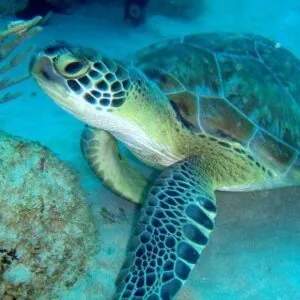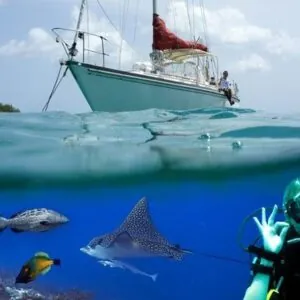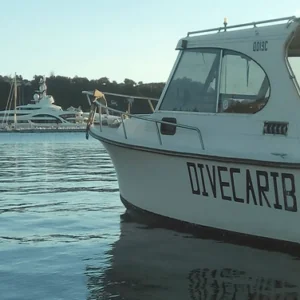Located at the northern end of the Caribbean chain, Antigua and Barbuda are best known for the 365 white sandy beaches and turquoise blue water. The two islands offer divers diverse options for year-round underwater exploration including wrecks, reefs, corals, and an abundance of marine life. Since there is so much that a diver can see and explore in Antigua, it is best to plan and know exactly the sites and experiences one wants to have. The diving scene in Antigua has not made its mark on an international level, which gives divers a more laidback approach to the diving experience. Divers can expect to dive with parrotfish, angelfish, batfish, grunts, turtles, moray eels, lobster, eagle rays, barracuda, reef sharks, and black tip sharks. If turtles are on the diving agenda, Barbuda is a popular location. Turtles swim to the island to nest each year. A diver is likely to spot lots of turtles and even new hatchlings making their way to the ocean.
GETTING THERE
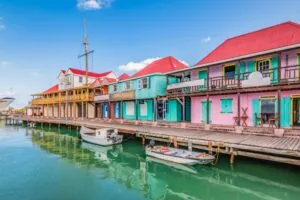
Antigua and Barbuda do not have its own national airline, but Delta, American Airlines and United fly direct routes from the USA. A valid passport is required.
GETTING AROUND
It is safe to travel by car in Antigua. Be prepared for dirt roads when traveling off the beaten path. The island does offer public buses which run from St. Johns, but they tend to serve local resident routes rather than tourist routes. Taxis are dependable and readily available.
GOOD TO KNOW
Country: Sovereign entity in the Lesser Antilles that belongs to the Commonwealth of Nations.
Time Zone: Atlantic Standard Time
Primary Language: English
Currency: East Caribbean Dollar/US currency is accepted everywhere.
Cell Phone Service: Antigua and Barbuda use GSM for their cellular service which most phones support.
Voltage: Standard voltage 230V. Those traveling from the US will need a voltage converter but do not need a plug adapter.
Hurricane Details: The official hurricane season is from July through November although the risk of hurricanes is extremely low.
DIVE CONDITIONS
Water Temperature: The seas around Antigua are always warm with surface temperatures never dropping below 78 degrees F.
Water Visibility: 50-140 feet
When to Go: December through April are the driest months in Antigua.
Diving Difficulty: Beginner – Advanced
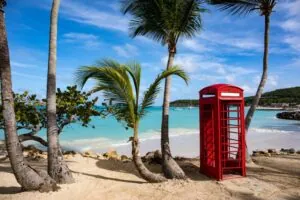
TOP DIVE SITES IN ANTIGUA AND BARBUDA
Antigua and Barbuda cater to the diving enthusiast! Listed are some of the very best that Antigua and Barbuda can offer divers:
- Jettias Wreck (Beginner) Located west of Sandals Grande; wreck divers can explore Jettias Wreck. Jettias Wreck is a French steam powered freighter that sank in 1817. It is one of the oldest wrecks off the coast of Antigua. Divers can expect to see trumpet fish, parrotfish, grunts, Spanish hogfish, barracuda, and snapper.
- Pillars of Hercules (Pillar’s Reef) (Beginner) Shaped like fingers, Pillar’s Reef has fantastic visibility. The Pillars of Hercules is named for the incredible rock face that surrounds this diving site. Over time, this reef has been carved by the wind and the waves and resembles columns that hold up the cliff face. The Pillars is located close to shore and is only 33 feet in depth. This makes it a wonderful site for beginner divers, snorkelers, and free divers. A variety of colorful reef fish swim below the columns as well as colorful corals. A small swim through containing feather dusters and Christmas tree worms enhances this dive experience.
- Mary Kay Reef (Beginner) Known for its abundance of soft coral heads and reef fishes, Mary Kay Reef has small ledges and undercuts to explore. There is a high possibility of spotting lobsters and barracudas as well as turtles and stingrays.
- Chimney’s Reef (Advanced) Due to its depths of 40 feet and reaching up to 85 feet, Chimney Reef is best for divers with experience. The reef slowly tapers down to a point at which it dramatically drops off. Divers can see up to 100 feet into the deep blue while swimming with Atlantic spadefish, black jacks, angel fish, barracudas, and nurse sharks. This extensive reef is perfect for drift diving. Divers will follow the ridge up to a small cave called “the chimney” where Glass Eye snappers and Soldier fish live. From the cave, divers can watch the reef below where giant pufferfish and balloon fish are often hiding between the soft corals. Nurse sharks enjoy hiding under ledges and overhangs and reef sharks are abundant and curiously watch divers. Big schools of pelagic fish and large lionfish are often spotted.
- Rambo’s Reef (Advanced) Rambo’s Reef is a deeper dive and best suited for divers with more experience. The ledge drops down 100 feet to and is home to many intriguing marine species. Divers can see reef fishes, turtles, lobster, stingray and more.
- Monk’s Head (Beginner) This dive is worth putting on a dive agenda. The depth of this reef is around 50 feet with a circular knoll. Monk’s Head is home to trumpet fish, parrot fish, snappers, Creole wrasse, Atlantic spadefish, and southern stingray.
- Roads (Beginner) Roads is not one of the most popular dives in Antigua, but it is a calm and easy dive. The prominent feature of Roads are coral heads and short pillars. The name of this reef comes from its resemblance of an undersea road. The chances of encountering schools of fish and turtles are high.
- Snappers Ledge (Advanced) Snappers are commonly seen at this reef as are other fish species including big eye jacks, Spanish mackerel, and barracuda. At 50 feet, the ledge drops to 80 feet. Divers have called this an absolute favorite for the experienced diver due to the incredible stadium-like topography. The reef rises from sand at 79 feet to form an incredible wall. There are overhangs where Caribbean Reef lobsters gather. There are common sights of large Yellow Tail and Mahogany Snappers. Following the walls of the Stadium, divers swim with colorful sponges and hard corals. In the deeper sections of this reef, Reef Sharks patrols the area. The outside of the wall is home to reef sharks and nurse sharks swimming through the sandy channel. Divers have the unique opportunity to mingle with the resident Nurse shark named George (found out later to be a girl) who is curious and enjoys interacting with cameras and local dive guides.
- Cades Reef (Beginner) Due to the location of this reef, Cade Reef is perfect for both snorkeling and scuba diving. This shallow reef has wonderful sights, including parrotfish, lobster, and eels as well as eagle rays, moray eels and barracuda. Nurse sharks enjoy swimming in this area under the coral overhangs where they go to rest.
- Kay Point Reef (Beginner) This is an exciting and easy to navigate reef and is popular for divers just receiving certification. Circular in appearance and with an abundance of sea fans, barrel sponges and other types of corals, divers occasionally spot nurse sharks and black tip sharks.
- Captains Anchor (Beginner) Green and Hawksbill turtles are common visitors to this reef. A large anchor sits 60 feet under the water and came from a 19th-century ship that ran aground while coming onto shore. Divers often spot green moray eels on top of the reef. There are small overhangs and sandy channels where sea creatures hide, including turtles during mating season.
- Coral Gardens (Beginner) Just behind Cades Reef lays Coral Gardens. This is a wonderful dive site for beginning divers. As the name suggests, this site offers a stunning garden including coral boulders and a beautiful high rising wall. Triggerfish dart around the reef close to the surface of the water. The wall has various tiny cuts and crevices in the reef where Reef Lobsters and Coral Crabs hide. Nurse Sharks frequents this reef seeking shade and rest under the coral boulders or amongst the reefs. The sandy floor offers the Southern Stingray a serene spot to wait for a dinner of small shellfish.
- School House (Beginner) This site offers an abundance of countless varieties of tropical fish such as Blue and Brown Chromis, Sergeant Majors, and Creole Wrasse. Reef fish in large schools’ swim along the sandy channel. Within the crevices, divers will see spotted lobsters, Red and White Banded Shrimp and various varieties of Moray Eels. At 33 feet in depth, this vibrant colored branching reef gives divers unobstructed views of the ocean in every direction.
- Sharks Edge (Beginner)Due to the shallowed sloped edge, this dive is appropriate for beginner divers. This reef name comes from the abundance of reef and nurse sharks that congregate in this area. Swimming through these beautiful spreading reefs, divers can see both sandy patches and great long stretches of the reef. Caribbean Reef Octopus congregate here. This is also a great site to see Spotted Eagle Rays.
- Solomon’s Trail (Advanced) If looking for an adventure, this diving site is necessary for the most experienced diver. At a depth of 57 feet, this diving site divers can be experience it from different angles which makes it a popular repeat dive. It is quite common to see schools of Barracuda and different and unique pelagic fish. Horse Eye Jacks, Almanco Jacks, Bar Jacks, Amber Jacks are common visitors to Solomon’s Trail for divers to enjoy.
- Sunken Rock (Advanced) When the weather allows, this magnificent dive is located on the southern corner of the island. It can be subject to high winds coming from the Atlantic. This is a beautiful dive site where depths can reach up to 98 feet. The pinnacle is home to large lobsters walking among the reefs. Schools of exceptionally large Yellowtails, snappers, Nassau Groupers and Rock hinds make this dive unforgettable.
- Stingray City (Beginner) Found on the Northern coast of Antigua in the clearest turquoise water, patch reefs surround this area. Visitors can come into the water to swim and interact with Southern Stingrays that swim to this lagoon. This area is great for families with small children and snorkelers as the depth can be as shallow as 3 feet.
- Palmetto Point (Barbuda) (Advanced) Beginning as a barrier reef in the shallows, this reef drops off into depths of 50 feet. At this site, divers can appreciate hard corals such as Brian corals and Starlet corals. In the protected areas divers can discover colonies of staghorn corals. Queen conch, Tritons Trumpet, Southern Stingrays and Spotted Eagles Rays visit this reef often.
- Palaster Reef (Barbuda)(Beginner) Known as a hot spot for marine life, divers will experience an abundance of Caribbean Reef Lobsters along with schools of barracudas, Bermuda Chubs, and Parrotfish. Green turtles are often found basking in the warm shallow and clear blue waters.
TOP ATTRACTIONS IN ANTIGUA AND BARBUDA
- Nelson’s Dockyard National Park
- Fort James
- Devil’s Bridge National Park
- St John’s Anglican Cathedral
- Heritage Quay
- Museum of Antigua and Barbuda
- Shirley Heights
- Betty’s Hope Historic Sugar Plantation
- Stingray City
- Dickenson Bay
- English Harbour
With an incredible assortment of underwater species, vast coastlines and ideal weather conditions, these islands offer an extraordinary diving opportunity and experience. The pristine and well-preserved reefs are home to marine life of all kinds. Wall dives, drift dives and shipwreck explorations are the unique gifts waiting for divers under the island’s clear turquoise waters. Diving in Antigua and Barbuda should top any diving enthusiast’s bucket list.

